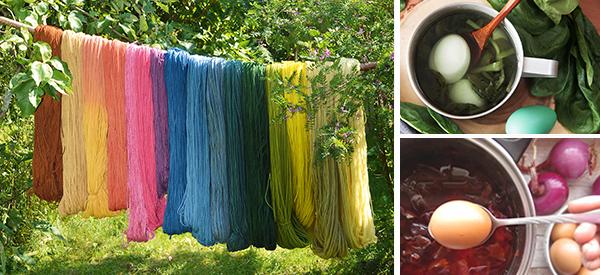
How To Naturally Dye Your Everyday Items
As much as we love coloring our everyday items, the dyes we use often contain super harsh and harmful chemicals. Wouldn’t it be great if we could replace synthetic dyes with natural dyes?
Natural dyes, as the name suggests, come from natural sources, such as plants or minerals. Moreover, biological sources such as vegetables and fungi give the majority of natural dye production. These are non-toxic, renewable, and safe for human consumption. They are used to dye various items, such as hair, clothes, Easter eggs, and many more.
In this article, we will discuss what the sources of natural dyes are, what colors they will produce, some of the detailed examples of how they can be made, and what the everyday items that you can dye are.
Here is a small list of materials you can use and the colors you’ll get:
- Any red leaf (reddish-brown)
- Artichokes (green)
- Avocado from skin and seed (a light pink hue)
- Bamboo (turkey red)
- Beets (deep red)
- Bougainvillea (pink)
- Butternut squash husks (yellow/orange)
- Celery leaves (yellow)
- Coffee grounds/tea (brown)
- Coreopsis flower (yellow)
- Dandelion roots (brown)
- Daylily blooms (red/purple)
- Eucalyptus (all parts, leaves, and bark) shades of tan, deep rust red, yellow, green, orange, and chocolate-brown.
- Hibiscus bushes (red)
- Hyacinth flowers (blue)
- Lavender (pink)
- Madder roots (red/brown)
- Onion skins (yellow/orange)
- Red cabbage (blue/purple)
- Red clover (gold)
- Roses (pink)
- Spinach (green)
- Strawberries/cherries (pink)
- Turmeric (yellow)
- Walnut hulls (brown)
Below are some of the examples of materials, how to make dye out of it, and where to use these natural dyes:
1. Hibiscus
The flowers and leaves of hibiscus bushes are used to produce lovely reddish hibiscus dye. When crushed, it turns black and yields a purplish dye.
How to make hibiscus dye: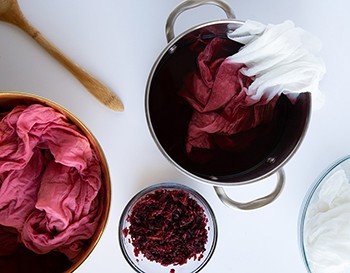
- Simmer the flower heads gently in filtered water for about 30 minutes
- If the water gets too hot, the dye will lose its attractive pinkish hues and turn brown.
- Remove all the plant material after you have created the hibiscus dye.
- The intensity of the color will depend on how much dye you use in ratio to the yarn or fiber you are dying
Where to use: It is used as hair dye and to dye yarn or fiber. For a light purple color, it can be used on wool and for deep pinks to dark grays on linen and cotton using different mordants.
2. Coreopsis
This is a common garden flower that is easy to grow and yields beautiful yellows, oranges, and browns.
How To Make Coreopsis Dye: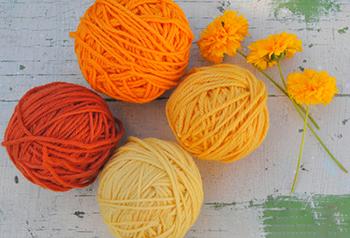
- Harvest the coreopsis flowers, and soak the flowers overnight in a pot.
- Add 20 to 24 ounces of water.
- Bring the water to a boil, and turn it down to simmer.
- Simmer until the flowers lose their color.
- A coreopsis dye bath is sensitive to pH; a small amount of lemon juice will change the color toward yellow, and a pinch of soda ash will bring out the reds.
Where to use: Coreopsis builds stronger colors on wool or silk, and it is not suggested for dyeing cotton and other vegetable fibers.
3. Madder
This is a Eurasian herb with whorls of leaves and small yellowish flowers. Its root has rubia tinctorium alizarin, which is a dye molecule and creates a turkey red color.
How to make madder dye:
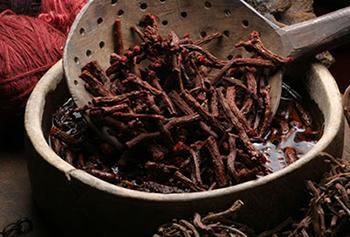
The rule of thumb when considering harvesting madder is “the older the plant, the stronger the color.
- Extract the madder root from the madder plant (mature plant between three to five years old or more).
- Heat the dye vat (not higher than 82 degrees Celsius).
- Hold the temperature for 45 to 60 minutes to increase the intensity of the color.
- Don’t allow it to heat above 82 degrees Celsius, because the red color will fade away and yellow will come out, resulting in a brownish color.
- You can simmer the root several times, extracting varying colors, until no more color is seen.
Where to use: Use to dye mainly wool and silk.
4. Onion
Onions are available in your local supermarket, or you can grow your own. Onion skins give you yellow, red, green, and purple dyes that can be easily extracted. It does not need any mordant as the skin already produces its tannins. Tannins act as mordant in this case. The greater the quantity of onion skin, the darker the color will be.
How to make onion dye: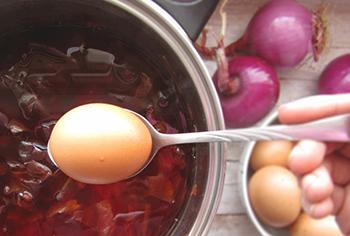
- Put the onion skins into the pot.
- Fill it up with water and cover.
- Bring the water to a boil, and let it simmer for about an hour.
- Strain out the onion skins from the pot.
- Collect the rich-colored onion dye.
Both red and purple onions can be used to make dye.
Where to use: You can dye natural fabrics, which are the best materials for color, including wool, hemp, and cotton. Also, you can soak the prepared eggs with onion dye and simmer them for 20 minutes. You will get Easter eggs with a vibrant, deep red color.
5. Red cabbage
Red cabbage is truly nature’s gift. It not only provides nutritional value but also gives wonderful colors. It has a pigment molecule called anthocyanin that makes it good for both health and to use as a dye. Red cabbage produces different results depending upon the pH of the dye bath. The color varies from purple to red or blue. Changing the pH is easy by adding ammonia to make it alkaline or some vinegar to increase the acidity level.
How to make red cabbage dye: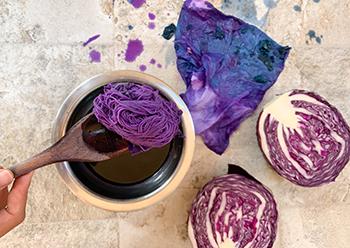
- Finely chop the cabbage, and place it in the dye pot.
- Cover it all with water, and add a tablespoon of salt for every half cabbage.
- Simmer for about half an hour, until you see the change in color.
- Strain off the cabbage, and extract the color.
- You now have purple-colored red cabbage dye. Adding a tablespoon of ammonia will change the color to blue. If you add 2 tablespoons of white vinegar, then it will change to a lovely pink color.
Where to use: It imparts wonderful colors on both synthetic and natural fabrics, and you can use it to color yarn. You can also use it to paint with. It can be used to dye Easter eggs as well.
Other than the mentioned uses of natural dyes, natural products such as cocoa powder and henna can also be used to color your hair.
6. Turmeric
Turmeric is highly valued in natural medicine as well as textiles. Its gorgeous color and healing properties have earned it the nickname “Indian solid gold”- indeed it has quite the reputation.
How to make turmeric dye:
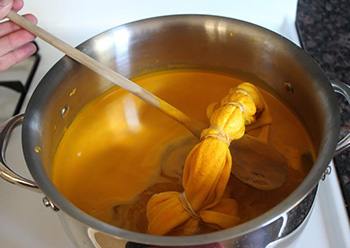
- Bring a medium/ large pot of water to simmering heat
- Add 1/4 to 3/4 cup of turmeric (depending on the density of yellow desired) to the pot and simmer for 20-30 mins
- Submerge your fabric in solution.
- Bring to boil and let simmer for approximately 1 hour. This will allow the dye to take to the fabric.
- Remove pot from heat and remove fabric from pot placing it into a colander style pot. If you don’t have one then the kitchen sink is fine. (Remember, porcelain and ceramic may stain so best to use a stainless steel sink!)
- Rinse thoroughly to remove any excess powder
- Hang to dry
7. Spinach
There is more than one way to make use of fading veggies like old spinach leaves. Although most gardeners put a high value on composting kitchen detritus, you can also use past-their-prime fruits and veggies to make homemade dye.
How to make spinach dye:
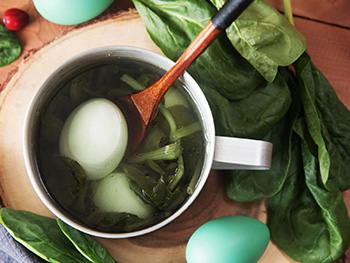
- Chop up the spinach and put the chopped pieces in the blender.
- Add two cups of hot water for every cup of spinach.
- Then strain the mixture through a cheesecloth-lined strainer and add a tablespoon of table salt.
- Add twice as much water as you have spinach, bring it to a boil, then allow it to simmer for an hour.
- Once the product has cooled, strain it well.
- Then you can start using spinach to dye fabric.
Where to use: The best way to create long-lasting dyed clothing is to first use a fixative on the fabric. You’ll need to boil the fabric in saltwater (1/4 cup salt to 4 cups water) for fruit-based dyes, or one cup vinegar and four cups water for veggie-based dye like spinach. Boil for one hour. When done, rinse the fabric in cold water. Squeeze it out, then soak it in the natural dye until it reaches the desired color.
You can also use the plant dye with kids as a natural coloring for Easter eggs. Simply soak the egg in the dye until it reaches the hue you desire.
The list is endless, but before starting with natural dyes, there are few things that you should keep in mind:
- All dyed fabrics, whether synthetic or natural, should be laundered in cold water and separate from other items.
- It is best to use a large pot as your dye vessel.
- Always wear gloves to handle the dye because it can stain your hands. Use natural rubber gloves.
You may also like:
 How to Make an Alcohol Extraction with Goldenseal to Fight Inflammation
How to Make an Alcohol Extraction with Goldenseal to Fight Inflammation
“The Superberry” That You Should Gather for A Profit (And Where to Find It) (Video)
10 Teas That Should Always be In Your Cupboard

Howdy — Great info! Is there a natural dye to make grey hair light blond?
I read about amla having this effect on hair in a book called Natural Hair Coloring by Christine Shahin. I wish there were all plant- based hair spas that specialized in silver locks.
Thank you for this info! I got the book. This sounds like an excellent solution!
Is there a dark decaf tea or decaf coffee, etc I can safely yse to dye my gray and light brown hair to med/dark brown?
Hi Michelle,
You can use coffee. Brew 2 cups of dark roast coffee and let it cool down. Let the coffee completely cool until you no longer see any steam coming out of the cup.
Once the coffee has completely cooled, add in 2 cups of your preferred conditioner. It’s best if the conditioner is extra moisturizing and thick because it will make the application easier. Then, add 4 tbs of coffee grounds. Mix all of the ingredients together with a spoon until the ground coffee dissolves and the mixture is smooth and black.
Apply the coffee mixture to your hair. Use a wide-tooth comb to even out the mixture throughout your hair and leave it in for no more than 1 hour.
Put a plastic shower cap on after applying the mixture to your hair.
After 1 hour, it is time to rinse the mixture out of your hair. Stand in the shower and rinse your hair until the water runs clear.
Do not add shampoo to your rinse. It will remove all of the color you just applied. (You should wash and dry your hair before applying the dye).
Thank you. But will decaf coffee work? The caffeine from reg coffee, will affect me, even using as a dye.
What do I use to make black for my hair to cover the grays and silvers
Hi Leslie,
One of the most popular natural hair dye ingredients, henna is a powdered form of the leaves that come from the henna plant. These leaves have a natural and effective coloring pigment that has been used for thousands of years to dye hair, nails, and skin.
Coffee works great if you’re looking to cover gray hairs (see the detailed recipe in the previous comment).
Rosemary, nettle, and sage are all great herbs for dark hair. Simmer all three with water for 30 minutes, cool, strain, and spray or brush through hair. Allow sitting for about an hour. You can also use the rinse daily after your shower. Be patient. It may take several days to notice a difference.
If you want to secure a dark brown color, walnuts are a good option. Crush the walnut shells and boil for about half an hour. Cool, strain, and apply to hair. If you’re wanting to cover grays, you can use a cotton ball to apply only to those areas where it’s needed.
Can you recommend a book for natural dying, or a website. I am interested in light green, medium blue and cream colors. Thanks